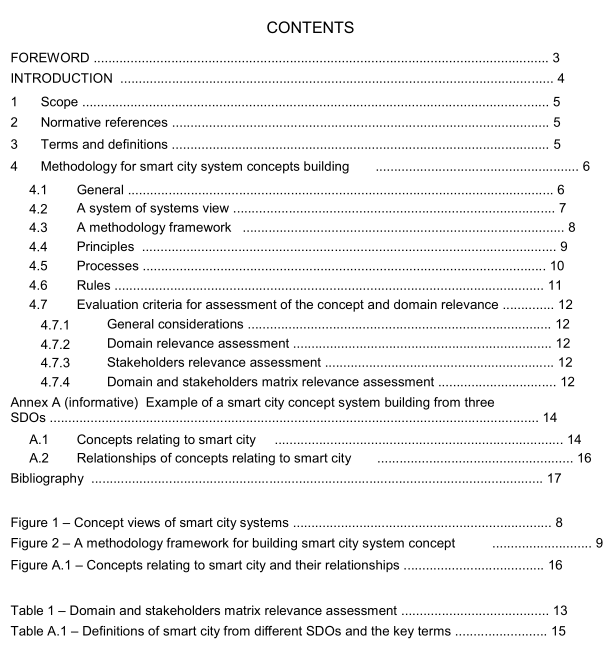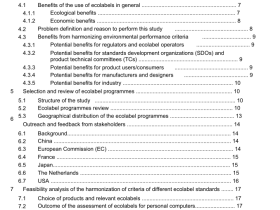IEC SRD 63235 pdf – Smart city system – Methodology for concepts building

IEC SRD 63235 pdf – Smart city system – Methodology for concepts building
Scope
This document,which is a Systems Reference Deliverable,provides a holistic system ofsystems approach to provide views, methodology framework, principles, processes, rules, and
evaluation criteria for smart city system concepts building.
The methodology is applicable to continual improvement of a future part of lEC 60050 on smartcity systems, but is not limited to it.
NOTE lt is planned that smart city systems will form the subject of lEC 60050-831.This document does not specify the definitions of a smart city system.
2Normative references
There are no normative references in this document.
3 Terms and definitions
For the purposes of this document, the following terms and definitions apply.
IsO and lEC maintain terminological databases for use in standardization at the followingaddresses:
.IEC Electropedia: available at http://www.electropedia.orgl
.IsO Online browsing platform: available at http:.//www.iso.orglobp
3.1
characteristic
abstraction of a property (3.5)
Note 1 to entry: Characteristics are used for describing concepts (3.2).
[SOURCE: ISO 1087:2019,3.2.1, modified -The EXAMPLE has been deleted.]
3.2
concept
unit of knowledge created by a unique combination of
characteristics (3.1)
Note 1 to entry. Concepts are not necessarily bound to particular naturallanguages. They are, however,infuencedby the social or culturalbackground,which often leads to different categorizations.
Note 2 to entry. This is the concept “concept as used and designated by the term “concept”in teminology work.lt is a very different concept from that designated by other domains such as industrial automation or marketing.
[SOURCE: ISO 1087:2019,3.2.7]
3.3
concept systemsystem of concepts
set of concepts (3.2) structured in one or more related domains (3.4) according to the conceptrelations among its concepts (3.2)
[SOURCE: ISO 1087:2019,3.2.28]
3.4
domainsubject field
field of special knowledge
Note 1 to entry: The borderlines and granularity of a domain are determined from a purpose-related point of view.lf a domain is subdivided, the result is again a domain.
[SOURCE: ISO 1087:2019,3.1.4]
3.5
property
feature of an object
Note 1 to entry: One or more objects can have the same property.
[SOURCE: ISO 1087:2019,3.1.3, modified – The EXAMPLES have been deleted.J
3.6
term
designation that represents a general concept by linguistic means
[SOURCE: ISO 1087:2019,3.4.2, modified – The EXAMPLEand Note 1 to entry have beendeleted.]
4Methodology for smart city system concepts building
4.1General
Methodology refers to a coherent, integrated set of methods from which a coherent sub-set canbe selected for particular applications. A methodology for building smart city system conceptsshould contain at least six components:
a) a system of systems view with common concerns and interests of multiple stakeholders(see 4.2);
b) a methodology framework of constructs essential to the problem (see 4.3);
c) a set of principles guiding the scopes of concept and taxonomy of a smart city system(see 4.4);
d) a set of procedures suggesting the direction and order to proceed (see 4.5);e) a series of rules identifying things to be avoided (see 4.6); and
f)a collection of evaluative criteria for assessing the quality of the product (see 4.7).NOTE Adapted from the definition of methodologyin ISOIEC16500-8:1999,3.14.
4.2 A system of systems view A system of systems view (see Figure 1) considers the smart city as a complex system, made up of many vertical domains such as transport, health, education, and employment. These vertical domains are interconnected by three cross-cutting systems that include views of social system, digital system and physical system of a city and system approach, which work together as a complementary whole in responding to the concerns and interests of different stakeholders (ISO/IEC 30182:2017, 2.14).
Each of these cross-cutting systems, in turn, can be subdivided into other horizontal, cross-cutting domains. Taking this system of systems view enables the total capability of a city to be enhanced in a way and to an extent that none of the constituent systems can accomplish on its own. Each constituent system is a useful system by itself, having its own management, goals and resources, but when coordinated within the smart city system (SCS) contributes to providing the unique capability of the SCS.
The social system provides a multi-dimensional governance framework (ISO/IEC TR 38502:2017, 3.1) for coordinating arrangements of strategies, policies, decision- making structures and accountabilities to multiple stakeholders’ concerns in social space and convergence. A digital system provides a multi-domain architecture framework (ISO/IEC/IEEE 24748 ‑1:2018, 3.7) for cooperating activities of conventions, principles and practices for individual domain architecture and enabling digital transformation. A physical system provides a multi-layer application framework (ISO/IEC/IEEE 24765:2017, 3.177) to connect artefacts in each subsystem and enable interfaces between systems in physical space to support all necessary interactions. An integration of the three systems supports the convergence of multi-dimensional, multi- domain and multi-layer concerns and interests of multiple stakeholders as well as enhancing the adaptive capacity of a city as an ecosystem to deliver a sustainable, prosperous and inclusive future for its citizens.









